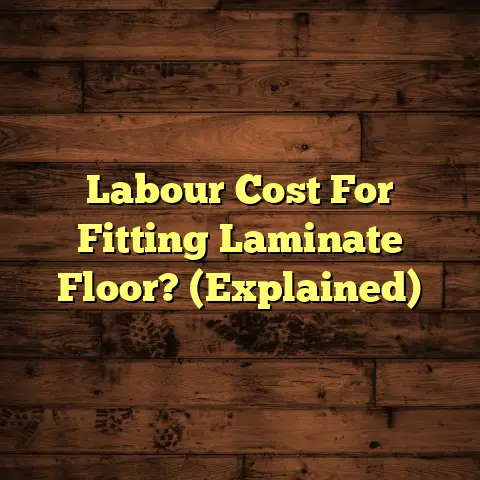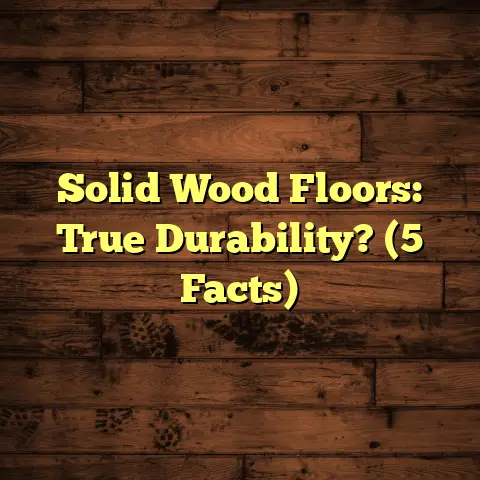Hardwood Floor Refinishing Costs in the Philippines
Refinishing hardwood floors can breathe new life into your home, enhancing its aesthetic appeal and increasing its market value. However, understanding the costs involved in this process is crucial for homeowners considering this investment. This guide provides a detailed overview of the major cost factors, price breakdowns, comparisons with alternative flooring options, and advice on maintenance and contractor selection.
Overview of Major Cost Factors
When estimating the cost to refinish hardwood floors in the Philippines, several critical factors come into play:
1. Area Size
The size of the area that needs refinishing directly impacts the overall cost. Larger spaces will require more materials and labor, leading to higher expenses. For instance, refinishing a small room (around 20 square meters) will generally cost less than a large living room or an entire house.
2. Type of Hardwood
Different hardwood species have varying costs associated with them. Common hardwood types include:
- Mahogany: Known for its rich color and durability, it is often more expensive due to its desirability and availability.
- Teak: Highly valued for its resistance to moisture and pests, usually comes at a premium because of its longevity and beauty.
- Acacia: A more affordable option with unique grain patterns that appeal to many homeowners.
Understanding the type of hardwood you have or wish to install can significantly affect your overall refinishing costs. Each species has its properties that may influence not only the price but also the method of refinishing required.
3. Labor Costs
Labor costs can vary significantly depending on the region and the experience level of the contractor. In urban areas like Manila or Cebu, labor tends to be more expensive than in rural locations. Factors that influence labor costs include:
- Experience Level: More experienced contractors may charge higher rates but often deliver better quality work.
- Project Complexity: Intricate patterns or repairs will require skilled labor, thus increasing costs.
As a rule of thumb, it’s wise to gather multiple quotes from different contractors before making a decision.
4. Additional Considerations
Several additional factors can affect the overall cost of refinishing hardwood floors:
- Floor Removal: If existing flooring needs to be removed before refinishing, this will add to the overall cost. Removal may involve additional labor for safe extraction without damaging the underlying structure.
- Subfloor Replacement: If the subfloor is damaged, it may need replacement before refinishing can begin. This is an essential step that can add significant costs if not planned for.
- Material Grade: Higher-grade materials will increase costs but may offer better durability and aesthetics. For instance, premium finishes or specialty stains can enhance beauty but come at a premium price.
- Room Size/Layout: Unusual room shapes may complicate the installation process, potentially increasing costs. For example, tight corners or intricate designs require more time and effort to refinish.
- Installation Type: Different refinishing methods (e.g., sanding and sealing vs. chemical refinishing) come with varying price points. Traditional sanding is generally more labor-intensive than chemical methods but may provide superior results.
Detailed Cost Breakdown
Average Cost to Refinish Hardwood Floors
In the Philippines, homeowners can expect to pay between ₱50 to ₱150 per square meter for refinishing hardwood floors, depending on the factors mentioned above. Here’s a detailed breakdown based on area size:
| Area Size (sqm) | Estimated Cost Range (₱) |
|---|---|
| 20 | 1,000 – 3,000 |
| 50 | 2,500 – 7,500 |
| 100 | 5,000 – 15,000 |
| 200 | 10,000 – 30,000 |
Preparation Costs
Preparation is crucial in ensuring a successful refinishing job. These costs can include:
- Sanding: The process of sanding down the old finish can cost about ₱20 to ₱40 per sqm, depending on the condition of the wood.
- Repair Work: Fixing scratches, dents, or other damage may add about ₱10 to ₱30 per sqm.
- Cleaning: Thorough cleaning before refinishing is essential and may incur an additional cost.
Finish Application
Once preparation is complete, applying stain and finish will incur additional costs:
- Staining: Stains can vary widely in price based on quality and brand but typically range from ₱15 to ₱50 per sqm.
- Sealing: Applying a protective sealant adds another ₱15 to ₱50 per sqm, enhancing durability and appearance.
Total Cost Estimate Example
For a typical living room measuring 50 sqm, here’s how the cost could break down:
- Labor Cost: ₱3,500 (average)
- Preparation Cost: ₱1,200 (sanding and repairs)
- Staining and Sealing: ₱2,500
- Total Estimated Cost: ₱7,200
This example reflects average costs; actual figures may vary based on specific conditions and choices.
Comparison with Alternative Flooring Options
When considering refinishing hardwood floors, it’s helpful to compare costs with other flooring options:
| Flooring Type | Cost Range (₱ per sqm) | Longevity | Aesthetic Appeal |
|---|---|---|---|
| Hardwood | 50 – 150 | 50+ years | High |
| Laminate | 20 – 60 | 15-25 years | Moderate |
| Vinyl | 30 – 80 | 10-20 years | Moderate |
| Carpet | 20 – 50 | 5-15 years | Moderate |
Detailed Comparison
Hardwood Flooring
- Durability: Can last for decades with proper care.
- Aesthetic Appeal: Offers a timeless beauty that enhances home value.
- Environmental Impact: Sustainable if sourced from responsible manufacturers.
Laminate Flooring
- Cost Effectiveness: Generally cheaper to install but may not offer the same lifespan as hardwood.
- Appearance: Advances in technology have made laminate look more realistic, but it lacks the warmth of real wood.
- Water Resistance: Generally better than hardwood but can still be damaged by excessive moisture.
Vinyl Flooring
- Waterproof Options: Ideal for areas prone to moisture like kitchens and bathrooms.
- Maintenance: Easier to maintain than hardwood; however, it can be susceptible to scratches.
- Longevity: Typically lasts between 10 to 20 years but may need replacement sooner than hardwood.
Carpet Flooring
- Comfort: Provides warmth and comfort underfoot but generally does not last as long as hardwood.
- Variety of Styles: Available in numerous colors and patterns but can trap allergens if not cleaned regularly.
- Cost: Lower initial investment compared to hardwood; however, maintenance can be high.
Signs That Hardwood Floors Need Refinishing or Replacement
Determining whether to refinish or replace your hardwood floors involves assessing their condition. Here are signs that refinishing might be necessary:
Signs You Need Refinishing
- Dull Appearance: If your floors look lifeless despite regular cleaning, it may be time for refinishing. This dullness occurs when the protective finish wears away.
- Scratches and Dents: Minor wear can often be sanded out; however, extensive scratches may indicate it’s time for an overhaul.
- Water Damage: If water has caused warping or buckling in your hardwood floors, replacement may be required.
- Severe Color Fading: Significant fading can be restored through refinishing if the wood is still structurally sound.
Signs You Need Replacement
- Deep Gouges or Cracks: If your floor has deep gouges or cracks that cannot be repaired through sanding, replacement could be necessary.
- Extensive Water Damage: If water damage has caused structural issues or mold growth, it’s often more economical to replace rather than refinish.
- Age of the Wood: If your floors are very old (over 100 years), they might be beyond refinishing and could require replacement.
Pros and Cons of Hardwood Flooring
Pros
- Durability: Hardwood floors can last for decades with proper care and refinishing.
- Aesthetic Appeal: Their natural beauty enhances any interior space and increases home value significantly.
- Versatility: Hardwood fits various decor styles—from rustic to modern—making it a versatile choice.
- Eco-Friendly Options: Sustainable sourcing options are available for environmentally conscious homeowners.
Cons
- Cost: Higher initial investment compared to alternatives like laminate or vinyl flooring.
- Maintenance Requirements: Requires regular upkeep such as cleaning and occasional refinishing to maintain appearance.
- Susceptibility to Damage: Can be scratched or dented by heavy furniture or pets; some species are more prone than others.
Professional Installation vs. DIY
One primary consideration when deciding on refinishing your hardwood floors is whether to hire professionals or undertake the project yourself.
Cost Differences
Hiring a professional can cost between ₱50 to ₱150 per sqm, while DIY refinishing can save on labor costs but requires investment in tools and materials.
Professional Installation Benefits
- Expertise ensures high-quality results.
- Access to specialized equipment not typically available for DIY projects.
- Professionals are insured; this protects you in case of accidents.
DIY Considerations
If opting for DIY, ensure you have:
- Sanding machine (rental options available).
- Stain and sealant based on desired finish.
- Safety gear (masks, goggles).
Proper skills in handling tools are essential to avoid costly mistakes during installation.
Tools Needed for DIY Refinishing
- Sanding Machine: Essential for removing old finishes and preparing wood for staining.
- Orbital Sander or Detail Sander: For edges and hard-to-reach areas.
- Floor Cleaner: To clean dust and debris after sanding.
- Stain Brushes or Rollers: For applying stain evenly across surfaces.
- Sealant Applicator: A roller or brush specifically designed for sealant application.
Questions to Ask Hardwood Flooring Contractors
Before choosing a contractor for your refinishing project, consider asking these questions:
- What is included in your estimate?
- Ensure you understand whether labor, materials, and cleanup are included.
- How long will the project take?
- Get a clear timeline for when work will begin and when it will be completed.
- What kind of finish do you recommend?
- Discuss options such as oil-based vs. water-based finishes based on your needs.
- Can you provide references from previous clients?
- This helps gauge their reputation and quality of work.
- What are your payment terms?
- Understand upfront costs versus final payments after completion.
Care and Maintenance Tips for Hardwood Floors
To maximize the longevity of your hardwood floors:
- Regular Cleaning:
- Sweep or vacuum frequently to remove dirt and debris that can scratch surfaces over time.
- Avoid Excess Water:
- Use a damp mop instead of soaking wet cleaning methods; excess water can warp wood.
- Use Area Rugs:
- Place rugs in high-traffic areas to reduce wear; consider using felt pads under furniture legs.
- Refinishing Schedule:
- Plan for refinishing every 5-10 years depending on usage; this keeps floors looking their best.
- Humidity Control:
- Maintain indoor humidity levels between 30% and 50% to prevent wood from expanding or contracting excessively.
- Immediate Spill Cleanup:
- Clean spills promptly to avoid water damage; use gentle cleaners specifically designed for hardwood when necessary.
Additional Considerations Before Refinishing
Timing Your Project
Choosing when to refinish your hardwood floors is crucial; consider doing it during periods when you won’t need access to that space (like during vacations). This allows ample time for dust to settle post-refinishing without interfering with daily life.
Environmental Considerations
When selecting stains and finishes, consider choosing low-VOC (volatile organic compounds) products that are better for indoor air quality and environmentally friendly options that are non-toxic.
Choosing the Right Finish
Options include polyurethane (water-based vs oil-based), varnish, or penetrating oil finishes. Water-based finishes dry quickly and have lower odor levels but may not provide as warm a glow as oil-based finishes which take longer to dry but offer durability.
Conclusion
Refinishing hardwood floors can be a valuable investment that enhances your home’s beauty and longevity. By understanding the cost factors involved and comparing alternatives, you can make an informed decision on whether to refinish or replace your flooring. Always consider professional help for best results and maintain your hardwood floors effectively to enjoy their beauty for years to come.





